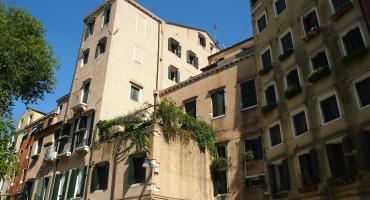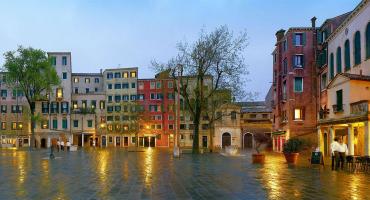The word ghetto, unhappily known worldwide, has Venetian origin. Sure enough, in the 16th century here was born the first isolation place for Jewish, whose toponym has origin from the presence in this area of old public foundries where they throw (“gettavano” in Italian) the bombards. The Venetian word gèto, probably influenced by the German accent, give birth to the word ghetto.
Jewish presence in Venice was dated to the Middle Age, however the documents in regard are really ambiguous. There is a reference of Jewish people in a document of 1152 regarding that year’s census, and in another one of 1290, in which it is mentioned a tax imposed on Jewish merchants. During these years, Jewish could move and freely live on the lagoon and on the neighboring hinterland.
Between 12th and 16th centuries, the Jewish community increased a lot: Germans, because of the intolerance atmosphere in Germany, Byzantines because of the Turkey’s chasing, and Spanish and Portuguese after the well-known banishment in 1492.
The Jewish community lived in an atmosphere of tolerance, but following this increase on March 29th, 1516 the Venetian Senate ordered all Jewish to live on an island of the district of Cannaregio, called Ghetto (later called Ghetto Vecchio, which means “Old Ghetto”).
This area was surrounded by walls, whose access were controlled by armed guards and closed at night with solid gates (whose hinges are still visible partly); Jewish were so obliged to live inside this area and couldn’t go out from dawn until
sunset.
Since the community flourished and increased, all buildings begun to vertically develop because of the small available surface. The houses reached eight floors, which is very rare in Venice, and this makes the area even more particular and appealing.
As time went by, the area increased absorbing in 1541 a nearby island, known as Ghetto Nuovo (new ghetto) and another area in 1663, called Ghetto Nuovissimo (the newest ghetto).
During 1500 many synagogues were built, one for each group.
These worship places, scarcely recognizable from the outside, were called Scuole (schools) or, better, Scole, and they are five: the German Scola Grande (1529), the Ashkenazi Jewish Scola Canton (1531-32), and the Italian Scola (1575), located in the Ghetto Nuovo’s Square; the Spanish Scola and the Sephardi Jews Levantino Scola (1538), located in the Old Ghetto.
The New Ghetto kept on living for more than two and a half century, until 1797, when Napoleon and the French conquered Venice and finally removed the gates and the restrictions; thus Jewish were free to go and live in other areas of the city.
Venetian Jewish community is now diminished comparing to the past; once there were a thousands member, now they are only 500 and a good part of them live out of Venice. It’s really painful to remember that, more than 200 people were deported from the Venetian Ghetto during the Second World War in the two tragic days of December 5th, 1943 and August 17th, 1944.
 The Israelite Rest Home is located in the New Ghetto, as well as the Holocaust Monument (1980), by the Lithuanian sculpture Arbit Blatas, dedicated to the Jewish community and its deported people.
The Israelite Rest Home is located in the New Ghetto, as well as the Holocaust Monument (1980), by the Lithuanian sculpture Arbit Blatas, dedicated to the Jewish community and its deported people.
There are also small porticos with columns once housing artisans’ shops and pawnshops; sure enough, usury was one of Jewish credit’s business since it was forbidden from religion to Christians, because making money out of loaned money was believed to be immoral.
Today the main business of the Ghetto is tourism.
Here there are the shops where to buy kosher products (prepared according to Jewish law): some shops, a restaurant, a pizzeria, a bakery, a coffee house and an ice-cream parlor. Typical Venice Jewish dessert are the "Orecchiette di Amman", with fruits stuffed, the “Bisce” with an “S” shape, the "Zuccherini" and the "Azime Dolci" a ring-shaped cake.



